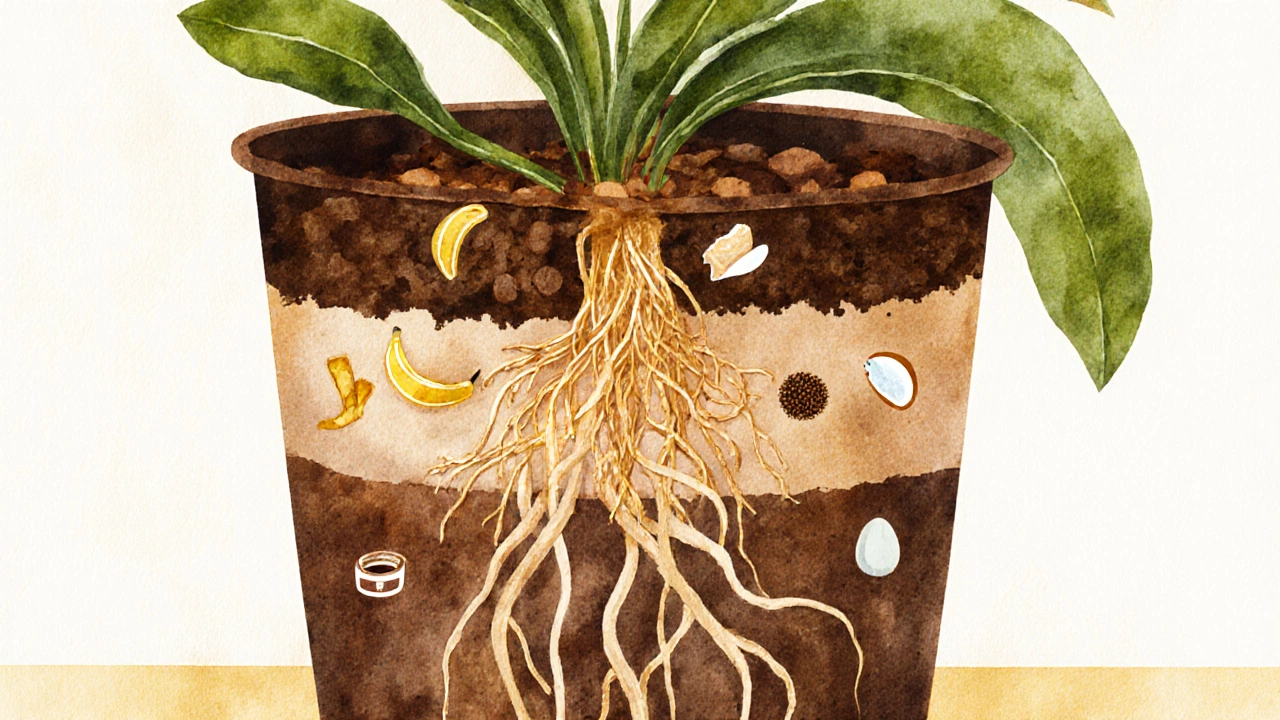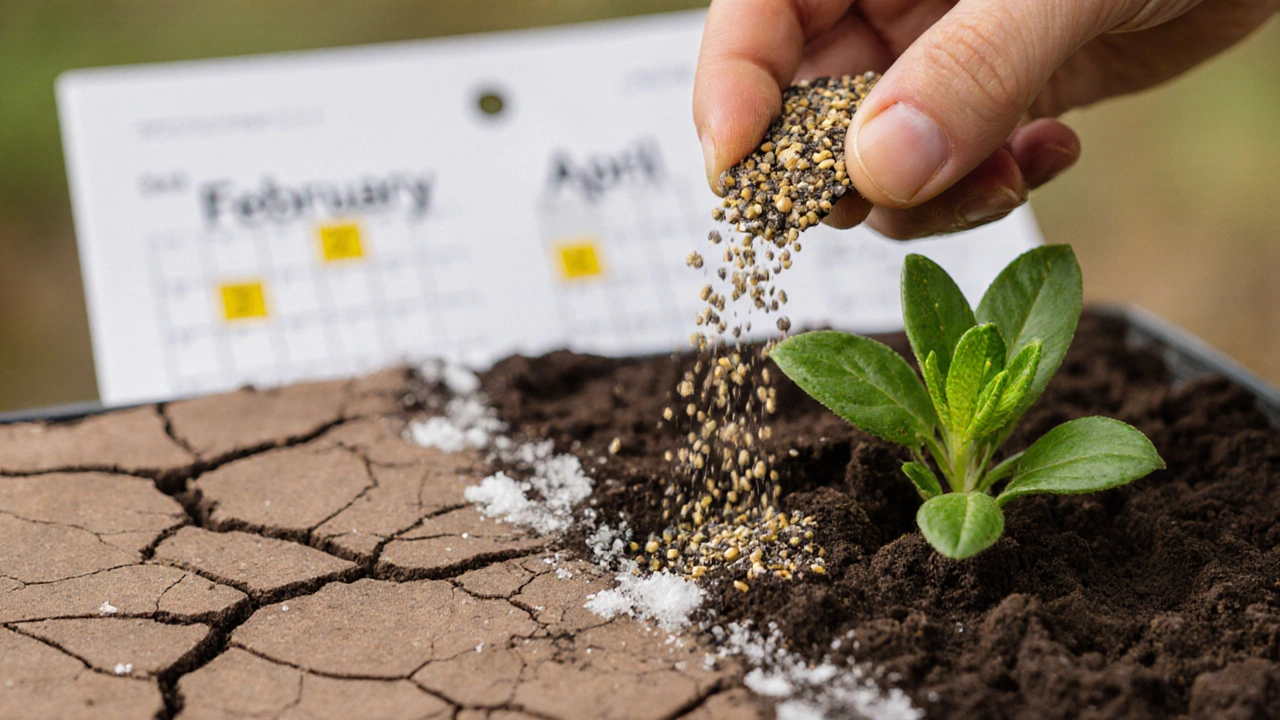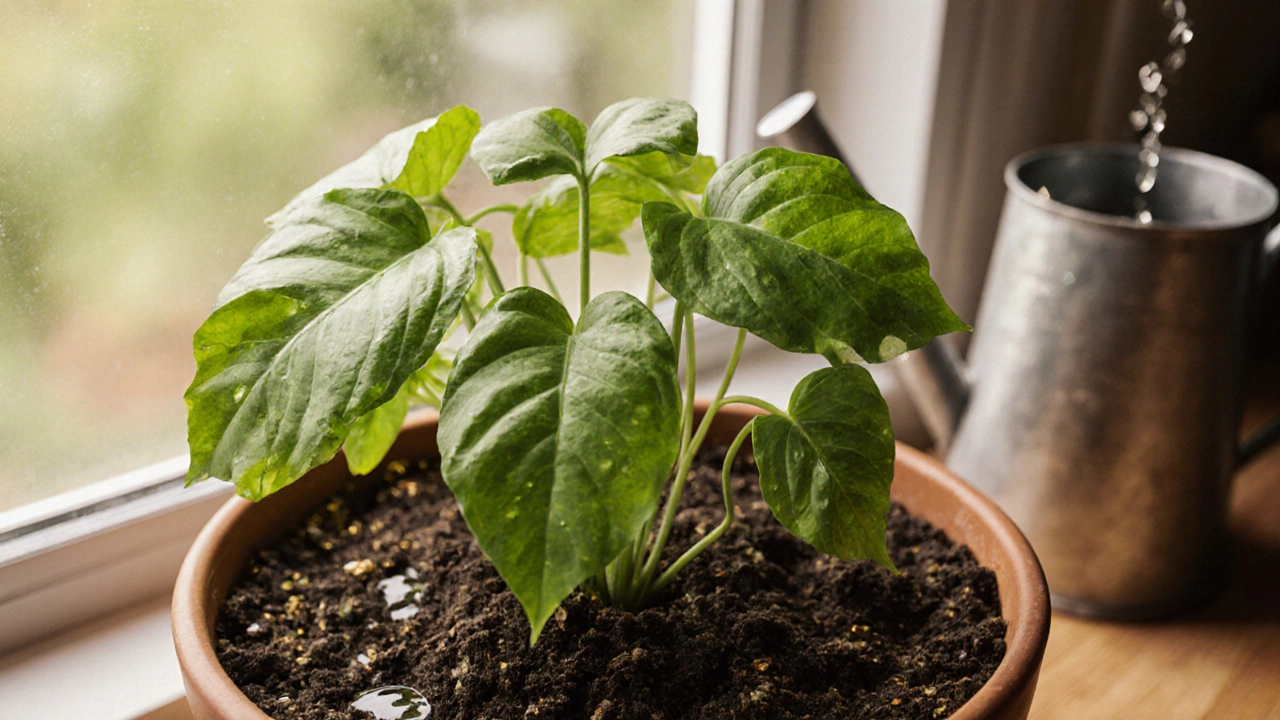Potting Soil Nutrient Recharge Calculator
Calculate the right way to replenish nutrients in your potting soil. Based on your plant type, pot size, and when you last fed, we'll recommend the best amendment and timing.
Ever noticed your houseplants slowing down? Leaves turning yellow, new growth stalling, or roots poking out the bottom of the pot like they’re trying to escape? It’s not always overwatering or too little light. More often than not, the problem is simple: your potting soil is empty. Not broken. Not dead. Just out of food.
Potting soil isn’t soil in the ground. It’s a mix designed to drain well and give seedlings a clean start. But that mix doesn’t come with a lifetime supply of nutrients. After a few months - sometimes just one growing season - the organic bits break down, the soluble salts wash out with every watering, and your plants are left starving. The good news? You don’t need to repot. You don’t need to buy new soil. You just need to feed it.
Why Potting Soil Loses Nutrients So Fast
Most commercial potting mixes are made from peat moss, coir, perlite, and vermiculite. These materials hold water and air, but they don’t hold nutrients. They’re like a sponge with no salt. The few nutrients in new bags come from slow-release fertilizers, usually good for 2-4 months. After that, it’s just empty medium.
Every time you water, you’re flushing out what’s left. Rainwater, tap water, even distilled water - it all carries dissolved minerals down through the soil and out the drainage holes. Plants use up nitrogen for leaves, phosphorus for roots and blooms, potassium for overall strength. Once those are gone, the plant shows it.
And here’s the catch: you can’t just add more fertilizer and call it a day. Too much, especially synthetic stuff, burns roots. Too little, and your plant just keeps fading. The trick is to rebuild the soil’s natural life, not just dump chemicals on it.
Step-by-Step: How to Recharge Your Potting Soil
There are five proven, safe, and easy ways to bring nutrients back into your potting soil. You can use one or combine them - it depends on your plant and your time.
- Top-dress with compost - Scoop off the top inch of soil (it’s usually compacted and stale). Replace it with half an inch of well-aged compost. Worm castings work even better. This adds slow-release nutrients and friendly microbes that help plants absorb them. Do this every spring or when you notice growth slowing.
- Use worm castings as a tea - Mix one cup of worm castings with five cups of water. Let it sit for 24-48 hours, then strain. Water your plants with this instead of plain water. It’s gentle, rich in nitrogen, and doesn’t risk burning roots. Do this once a month during growing season.
- Apply slow-release organic fertilizer - Look for granules made from bone meal, blood meal, kelp, or feather meal. Sprinkle a tablespoon or two on the soil surface, depending on pot size, and gently mix it in. These break down over 2-6 months. Avoid anything labeled “instant” or “quick feed.”
- Make your own compost tea with kitchen scraps - Save banana peels, coffee grounds, and eggshells. Dry them, crush them, and sprinkle a teaspoon around the base of your plant every 6 weeks. Banana peels add potassium. Coffee grounds add nitrogen. Eggshells add calcium. They won’t dissolve right away, but over time, microbes turn them into plant food.
- Add mycorrhizal fungi - These are beneficial fungi that form a partnership with plant roots. They extend the root system, helping the plant grab water and nutrients it couldn’t reach alone. You can buy them as a powder or liquid. Mix a pinch into the soil when top-dressing. Works best with herbs, succulents, and flowering houseplants.
What to Avoid
There are plenty of myths about reviving potting soil. Don’t fall for them.
- Don’t reuse old soil without refreshing it - Soil that’s been in a pot for over a year is often compacted, salt-heavy, and full of root fragments. Just topping it off won’t fix that. You need to physically replace part of it.
- Don’t dump fertilizer on top - Pouring granular fertilizer directly on the surface without mixing it in leads to uneven feeding and root burn. Always lightly incorporate it.
- Don’t use garden soil - It’s too dense for pots. It holds too much water and can introduce pests or fungi. Stick to compost, worm castings, or organic amendments designed for containers.
- Don’t overdo it - More isn’t better. One top-dressing every 4-6 months is enough for most plants. Overfeeding leads to salt buildup, which looks like white crust on the soil surface. If you see that, flush the soil with plain water for 10 minutes.

Signs Your Soil Is Actually Revived
How do you know it’s working? You’ll see changes within 2-4 weeks.
- New leaves are greener and fuller, not pale or stunted.
- Stems feel stronger. Plants don’t flop over as easily.
- Flowers or fruits appear where they didn’t before.
- Roots stop crawling out the bottom - they’re content where they are.
- The soil smells earthy, not sour or musty.
If your plant still looks tired after a full treatment, check the pot size. Maybe it’s rootbound. Or maybe it needs more light. But if the soil’s fed and the plant’s still struggling, the issue isn’t nutrition - it’s something else.
Seasonal Timing Matters
Plants don’t grow year-round. In the UK, most houseplants slow down after September. They’re not sleeping - they’re conserving. Feeding them in winter is pointless. You’re just adding fertilizer that won’t be used, which can build up and harm roots.
Best time to recharge your soil? Late February to early April. That’s when daylight returns and plants start waking up. A top-dressing of compost then gives them a clean, slow boost for spring growth. A second dose in June helps them power through summer. After that, let them rest.

What About Replacing the Soil Entirely?
Some plants - like orchids, succulents, or large tropicals - need fresh soil every 1-2 years. But for most common houseplants - snake plants, pothos, ZZ plants, peace lilies - you don’t need to repot. You just need to feed.
Repotting is stressful. It shocks the roots. It’s messy. It’s expensive. And if you’re doing it just because the plant looks tired, you’re wasting time and money. Reviving the soil is cheaper, gentler, and just as effective.
Only repot if:
- Roots are circling the pot tightly
- The plant dries out in two days, even after watering
- You’ve tried feeding and nothing changes
- The pot is cracked or the plant is top-heavy
Real Example: My Pothos That Wouldn’t Grow
I had a pothos in my kitchen window that hadn’t grown in a year. Leaves were small. Stems were thin. I thought it needed more light. I moved it. Nothing changed.
I took off the top inch of soil. It was hard, grey, and smelled flat. I added half an inch of worm castings and watered with compost tea. Two weeks later, a new leaf unfurled. By six weeks, it had three new vines. No repotting. No new pot. Just food.
That’s the power of soil revival.
Quick Checklist: Your Nutrient Recharge Plan
- Check soil every 4-6 months
- Top-dress with compost or worm castings in early spring
- Use compost tea monthly during growing season
- Add slow-release granules in spring or early summer
- Use kitchen scraps as minor supplements
- Never feed in autumn or winter
- Flush soil if you see white crust
Healthy soil isn’t about buying expensive products. It’s about working with nature. Your plants aren’t asking for fancy feeds. They just want their food back.
